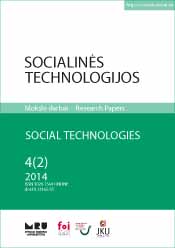TOWARDS A KNOWLEDGE COMMUNICATION PERSPECTIVE ON DESIGNING ARTEFACTS SUPPORTING KNOWLEDGE WORK
TOWARDS A KNOWLEDGE COMMUNICATION PERSPECTIVE ON DESIGNING ARTEFACTS SUPPORTING KNOWLEDGE WORK
Author(s): Niclas EberhagenSubject(s): Social Sciences
Published by: Mykolas Romeris University
Keywords: situated designing; knowledge work context; conceptual model; knowledge communication; computer-based artifacts.
Summary/Abstract: The designing of computer-based artefacts to support knowledge work is far from a straightforward rational process. Characteristics of knowledge work have a bearing upon how developers (or designers), together with users, come to approach and capture the rich and tacit knowing of the practice. As all knowledge work is about the production of knowledge, transforming it, so is the design practice for developing artefacts to occupy space within that same practice. There is a need for providing a conceptual language to better reflect the nature of this design work that goes beyond those dressed in the managerial (or rational) language of planned activities and deliverables. Towards this end, a conceptual frame is presented that makes several important aspects of the design practice visible. The frame brings together both nature of design work and characteristics of knowledge work to extend the frame of knowledge in user-developer communication of Kensing and Munk-Madsen. Thereby, providing a means to focus attention and dress debate on what situated designing is. By using explicit concepts, such as types knowledge domains embedded in the design situation, the transitional paths between them, and design engagements, it arms practitioners with specific linguistic constructs to direct attention and efforts in planning and organizing development undertakings.
Journal: Socialinės Technologijos
- Issue Year: 4/2014
- Issue No: 02
- Page Range: 268-284
- Page Count: 17
- Language: English

